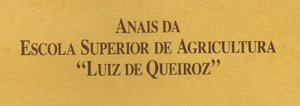Resumos
Por meio de colunas de terra, convenientemente preparadas em laboratório, em tubos cilíndricos, estudou-se a distribuição da umidade no momento da infiltração, aplicando-se água em forma de gotas, simulando chuva, a oito diferentes intensidades, com duas repetições para cada tratamento. Verificou-se que quando se reduzia a intensidade de aplicação da água, a intervalos mais ou menos constantes, aquele teor de umidade também decrescia, e vice-versa. Constatou-se também que, quando as intensidades de gotejamento eram muito pequenas, o teor de umidade se reduzia com menor intensidade, caminhando para um limite, ao qual se atribuia com lógica e senso, ser a capacidade de campo do solo.
The moisture content distribution along a soil profile at the water transient-state infiltration, depends on the rate of water application on the soil surface. Soil columns, prepared in the laboratory, by packing sieved and air dried soil into cilinder tubes were used to study the distribution of moisture content at the moment of infiltration. Drops of water, were applied simulating rain, at eight different intensities, called treatments, with two repetitions. It was found that when the water application rate was continualy reduced throughout the treatments, the moisture content also diminished and vice versa. It was also concluded that when the rain application intensity was decreasing to very small rate, the moisture content had shuch a slow redution, as if going to a limit, which was logically found to be the soil field capacity.
Hélio A. Manfrinato
Departamento de Engenharia Rural da ESALQ
RESUMO
Por meio de colunas de terra, convenientemente preparadas em laboratório, em tubos cilíndricos, estudou-se a distribuição da umidade no momento da infiltração, aplicando-se água em forma de gotas, simulando chuva, a oito diferentes intensidades, com duas repetições para cada tratamento.
Verificou-se que quando se reduzia a intensidade de aplicação da água, a intervalos mais ou menos constantes, aquele teor de umidade também decrescia, e vice-versa.
Constatou-se também que, quando as intensidades de gotejamento eram muito pequenas, o teor de umidade se reduzia com menor intensidade, caminhando para um limite, ao qual se atribuia com lógica e senso, ser a capacidade de campo do solo.
SUMMARY
The moisture content distribution along a soil profile at the water transient-state infiltration, depends on the rate of water application on the soil surface.
Soil columns, prepared in the laboratory, by packing sieved and air dried soil into cilinder tubes were used to study the distribution of moisture content at the moment of infiltration. Drops of water, were applied simulating rain, at eight different intensities, called treatments, with two repetitions.
It was found that when the water application rate was continualy reduced throughout the treatments, the moisture content also diminished and vice versa.
It was also concluded that when the rain application intensity was decreasing to very small rate, the moisture content had shuch a slow redution, as if going to a limit, which was logically found to be the soil field capacity.
Texto completo disponível apenas em PDF.
Full text available only in PDF format.
LITERATURA CITADA
Entregue para publicação em 18/2/1974.
- BAVER, L. D. & FRANSWORTH. Soil structure affects in the growth of sugar beets. Soil Sci. Am. Proc 5: 45-48. 1940.
- BODMAN, G. B., & COLMAN, E. A. Moisture and energy conditions during downward entry of water into soils. Soil Soc. Am. Proc. 8: 116-122. 1943.
- BUCKINGMAM, E. Contribution to on knowledge of the aeration of soils. U. S. D. A. Bur. Soils. Bull. 25, 1904.
- BUDGAWISKII, A. I. Infiltration of water into soil. URSS Academy of Sciences, Institute of Geography, Moscow 130. 1955.
- GOMES, F. P. Curso de Estatística Experimental. Piracicaba, Instituto de Genética, 1960. 229 p.
- MANFRINATO, E. A. A influência da intensidade de chuva na disponibilidade da água do solo às plantas. Tese Livre Docência. 1970. 100 p.
- MARSHALL, T. J. & STIRK, G. B. Pressue potential of water moving down ward into soils. Soil Sci. 68, 359-370.
- MEES, G. C. & WEATHERLEY, P. E. The mechanism of water absortion by roots. Proc. Boy. Soc. B, 147: 367. 1957.
- RANZANI, G., FREIRE, O. & KINTO, T. Carta de solos do Município de Piracicaba. Piracicaba Centro de Estudos de Solos. 1966. 85 p.
- RUBIN, J., STEINHARDT, R. & REINIGER, P. Soil-water relations during rain infiltration: II. Moisture content profiles during rains of low intensities. Soil Sci. Soc. Am. Proc. 28: 1-5. 1964.
- RUSSEL, E. J. & APPLEYARD, A. The atmosphere of the soil: its composition and the causes of variation. J. Agr. Sci. 7: 1-48. 1915.
- YOUNGS, E. G. The histeresis effect in soil moisture studies. Trans. Inte. Congr. Soil Sci. 7th Madison. 1: 107-113. 1960.
- WEBLEY, D. M. A. technique for the study of oxygen availability to microorganisms in soil and its possibile use as an index of soil aeration. J. Agr. Sci. 37: 249-256. 1947.
A irrigação por gotejamento I parte - influência sobre as relações solo-água
Datas de Publicação
-
Publicação nesta coleção
29 Maio 2012 -
Data do Fascículo
1974

